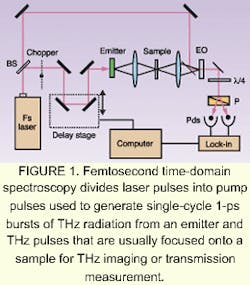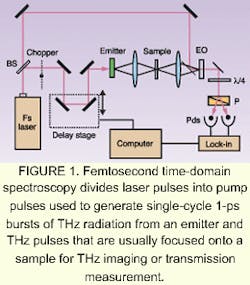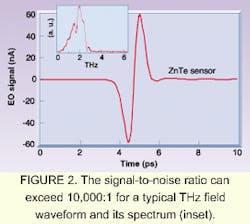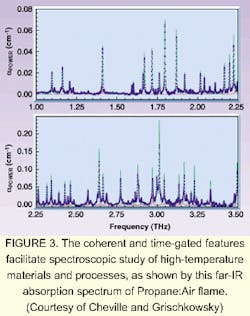Time-domain spectroscopy targets the far-infrared
Many biological and organic compounds have distinct signatures within the THz region that can be used to record and identify their chemical compositions.
Pengyu Han and Xi-Cheng Zhang
With a frequency exceeding a trillion cycles per second, the terahertz (THz) band occupies an extremely large area of the electromagnetic spectrum between the infrared and microwave bands. This far-infrared (IR) region is important because of the rich physical and chemical processes with spectrographic footprints within it. Up to as late as the 1970s, Fourier transform spectroscopy, which uses an incoherent blackbody source and a cryogenic bolometric detector, was the important spectroscopic technique in this region, but its performance was hampered by the lack of bright sources. The situation changed dramatically with the advent of THz time-domain spectroscopy in the late 1980s.
Terahertz time-domain spectroscopy is a direct extension of ultrafast optoelectronics. Early experiments in this area involved ultrafast electrical pulses generated and detected on photoconductive transmission lines under laser-pulse excitation. Researchers used miniature photoconductive dipole antennas to demonstrate single-cycle electrical pulses with THz bandwidth.1
Electrical-pulse generation and detection were restricted to the substrate of the transmission line until a breakthrough experiment used lenses to couple radiation in and out of the dipole antennas, making free-space time-domain spectroscopy a reality.2 Now, the technique also is benefiting from the proliferation of femtosecond-pulse lasers and VLSI fabrication techniques, and its applications are expanding dramatically.
Terahertz spectroscopy system
The major components of THz time-domain spectroscopy include a laser, a THz emitter and detector, focusing and collimating components for both the laser and the THz optics, samples, a chopper, a motorized delay line, a lock-in amplifier, and a data acquisition system (see Fig. 1). The femtosecond laser pulses are divided into pump and probe pulses. Pump pulses are used to generate single-cycle 1-ps bursts of THz radiation from an emitter, and THz pulses are focused onto a sample for THz imaging or transmission measurement. The THz pulses and probe pulses arrive simultaneously at an electro-optic (EO) sampling detection system, consisting of an EO crystal, a quarter waveplate, a Wallaston prism, and a pair of balanced photodiodes.
The THz electrical field relies on the Pockels effect to modulate the polarization ellipticity of the optical pulse passing the EO crystal. Because both pulse types derive from the same laser pulse, they are perfectly synchronized. The probe pulse is much shorter than the THz pulse, though, and is moved across the THz waveform by an optical delay line to record the THz waveform.
In time-domain spectroscopy, the signal-to-noise ratio (SNR) of the THz field can readily exceed 10,000:1 (see Fig. 2). It also usually takes two minutes to finish a THz waveform with 1024 data points using a lock-in time constant of 0.1 s. Most emitters thus radiate the THz pulses through either photo-carrier acceleration in an electric field or nonlinear optical processes. The electric field for acceleration of carriers can be applied from an external bias such as photoconductive antenna, or from an intrinsic one such as the surface depletion field. The nonlinear process for THz generation is usually optical rectification.
The photoconductive dipole antenna remains a key tool for coherent detection of THz spectroscopy, with the measured spectrum spanning from below 100 GHz to more than 4 THz. Electro-optic sampling, another excellent THz detector, is quickly gaining popularity.3 Both techniques determine the spectral resolution using the inverse of the optical delay time range and resolutions approaching 0.1 cm-1 are easy to reach.
Both techniques are insensitive to thermal background, which can be advantageous in high-temperature experimental conditions. The insensitivity is due to the use of phase-sensitive lock-in and time-gated detection. The detector is off most of the time between pulses because of the ultrafast response of the EO crystal or the ultrashort lifetime of the photocarriers in antenna substrate. Consequently, detector-noise equivalent power is about 10-16 WHz½2four orders better than possible with a helium-cooled bolometer in Fourier transform spectroscopy. Recently, high-bandwidth THz EO sampling has been demonstrated with a response up to 40 THz with a 15-fs pulse laser and a thin EO crystal.
Applications expand
The time-domain spectroscopic technique measures the THz electric field directly. Fourier transformation of the data then produces both amplitude and phase information. Because many rotational and vibrational spectra of various liquids and gases lie in the THz frequency band, the technique is a convenient way to study the real and imaginary parts of the dielectric function.
Recent applications of time-domain spectroscopy include the examination of the far-infrared properties of water and water mixtures, and the study of molecular vapor to derive the lineshape of collisionally broadened lines, as well as molecular collision time.4,5,6 The diverse range of applications results from the unique features of THz time-domain spectroscopy, including coherent sub-pico-second temporal resolution and time-gated detection.
The high temporal resolution, for example, has helped scientists directly observe Guoy shift and conduct THz ranging.7,8 The coherent and time-gated features facilitate spectroscopic study of high-temperature materials and processes. While incoherent thermal detectors used in Fourier transform spectroscopy can be easily overwhelmed by the copious amounts of far-IR radiation of high-temperature materials, the time-gated coherent detection of the time-domain technique is immune to it (see Fig. 3).
The technique also allows the study of the far-infrared properties of solids such as semiconductors, ferromagnetic materials, plastics, superconductors, organic materials, and quantum confined structures. Terahertz emission from materials has been used to study semiconductor interfaces, as well as the lattice and carrier dynamicsfeatures unobtainable with linear far-IR absorption spectroscopy. Other applications include carrier acceleration in the semiconductor surface fields, excitation of the charge wavepacket oscillations in quantum wells, and optical phonon dynamics in tellurium.
Plasmon oscillations also are the subject of recent research, with one project studying THz radiation waveforms from coherent longitudinal-optical phonon oscillations in an indium-phosphide surface. The time-domain technique allows gathering important information, such as phonon frequency, radiative phonon decay time, and phonon-plasmon mode coupling.
A very promising area of unique application for THz time-domain spectroscopy involves time-resolved optical-pump THz-probe experiments. Here, a third beam from the same laser used for THz generation and detection excites a sample such as a semiconductor, liquid, or superconductor. Researchers obtain the frequency-dependent dynamics as a function of time by varying the delay between the optical pump pulse and the THz probe pulse.
One recent research project studied transient THz transmission change in a solution of betaine in chloroform after excitation with an 810-nm pulse (see Fig. 4).9 For comparison, scientists also developed a pump-probe curve from the same sample using the 810-nm pulse as both pump and probe. Results indicate the far-IR probe can provide information on the heating of the solvent vibrational modes, which is unobtainable with the 810-nm probe pulse.
Outlook
There has been significant progress in THz time-domain spectroscopy since the first demonstration of THz imaging of tree leaves, bacon, and semiconductor integrated chipsimages of teeth and cancerous breast tissue are just two examples. The potential application field is quite broad since many biological and organic compounds have distinct signatures within the THz region that can be used to record and identify their chemical compositions.
FIGURE 4. The transient far-IR transmission through a solution of betaine in chloroform, after excitation with an 810-nm pulse (a). An 810-nm pump-probe signal from the same solution (b). Full lines are experimental data, while broken lines are fit to the data. Results indicate that the far-IR probe can provide information on the heating of the solvent vibrational modes, which is unobtainable with the 810-nm probe pulse (Courtesy of Haran and Hochstrasser).
Ultimately, the technique could help in the diagnosis of diseases, detection of pollutants, or quality control of food products and industrial products. There is even the potential to detect explosives, since plastic explosives look different under THz light and are distinguishable from the molecular structure of suitcases, clothing, and other household materials.10
Several research groups currently have turn-key THz time-domain spectroscopy and THz imaging systems in development. Equipment should be available for the commercial market in the near future.
REFERENCES
- P. R. Smith, D. H. Auston, and M. C. Nuss, IEEE J. Quant. Electron. 24, 255 (1988).
- C. Fattinger and D. Grischkowsky, Appl. Phys. Lett. 53, 1480 (1988).
- Q. Wu and X.-C. Zhang, Appl. Phys. Lett. 67, 3523 (1995).
- C. Ronne, P. Astrand, and S. R. Keiding, Phys. Rev. Lett. 82, 2888 (1999).
- D. S. Venables and C. A. Schmuttenmaer, J. Chem. Phys. 108, 4935 (1998).
- R. A. Cheville and D. Grischkowsky, Opt. Lett. 20, 1646 (1995).
- A. B. Ruffin et al., Phys. Rev. Lett. 83, 3410 (1999).
- R. A. Cheville, R. W. Mcgowan, and D. Grischkowsky, Phys. Rev. Lett. 80, 269 (1998).
- G. Haran, W. Sun, K. Wynne, and R. Hochstrasser, Chem. Phys. Lett. 274, 365 (1997).
- J. S. Bostak et al., SPIE 2211, 380 (1995).
PENGYU HAN is a graduate student and XI-CHENG ZHANG is a professor in the physics department, Rensselaer Polytechnic Institute, Troy, NY 12180



